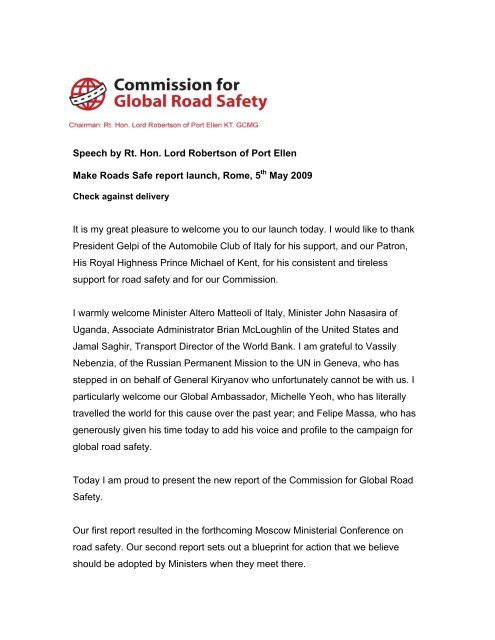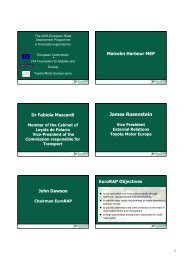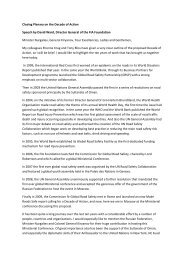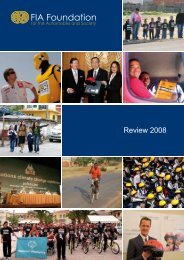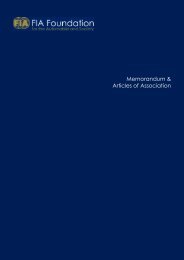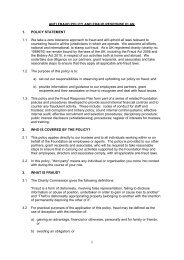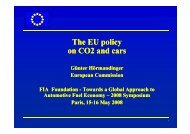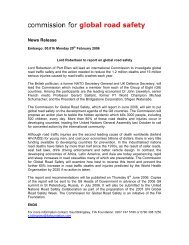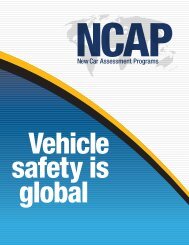Speech by Rt. Hon. Lord Robertson of Port Ellen ... - FIA Foundation
Speech by Rt. Hon. Lord Robertson of Port Ellen ... - FIA Foundation
Speech by Rt. Hon. Lord Robertson of Port Ellen ... - FIA Foundation
Create successful ePaper yourself
Turn your PDF publications into a flip-book with our unique Google optimized e-Paper software.
<strong>Speech</strong> <strong>by</strong> <strong>Rt</strong>. <strong>Hon</strong>. <strong>Lord</strong> <strong>Robertson</strong> <strong>of</strong> <strong>Port</strong> <strong>Ellen</strong>Make Roads Safe report launch, Rome, 5 th May 2009Check against deliveryIt is my great pleasure to welcome you to our launch today. I would like to thankPresident Gelpi <strong>of</strong> the Automobile Club <strong>of</strong> Italy for his support, and our Patron,His Royal Highness Prince Michael <strong>of</strong> Kent, for his consistent and tirelesssupport for road safety and for our Commission.I warmly welcome Minister Altero Matteoli <strong>of</strong> Italy, Minister John Nasasira <strong>of</strong>Uganda, Associate Administrator Brian McLoughlin <strong>of</strong> the United States andJamal Saghir, Transport Director <strong>of</strong> the World Bank. I am grateful to VassilyNebenzia, <strong>of</strong> the Russian Permanent Mission to the UN in Geneva, who hasstepped in on behalf <strong>of</strong> General Kiryanov who unfortunately cannot be with us. Iparticularly welcome our Global Ambassador, Michelle Yeoh, who has literallytravelled the world for this cause over the past year; and Felipe Massa, who hasgenerously given his time today to add his voice and pr<strong>of</strong>ile to the campaign forglobal road safety.Today I am proud to present the new report <strong>of</strong> the Commission for Global RoadSafety.Our first report resulted in the forthcoming Moscow Ministerial Conference onroad safety. Our second report sets out a blueprint for action that we believeshould be adopted <strong>by</strong> Ministers when they meet there.
Our headline recommendation is for the Moscow Ministerial to support, and theUnited Nations to adopt, a Decade <strong>of</strong> Action for Road Safety. The Decade <strong>of</strong>Action should be launched next year and should have as its goal a reduction <strong>of</strong>50% in the forecast level <strong>of</strong> road fatalities <strong>by</strong> 2020.Achieving this goal would mean that, instead <strong>of</strong> our roads killing nearly twomillion people a year <strong>by</strong> 2020, annual fatalities would fall below one million andwe will have set the world on a sustainable path to lower casualties and saferroads.In simple human terms achieving this goal would mean saving 5 million lives, andpreventing 50 million serious injuries, over the next ten years. The economicvalue <strong>of</strong> these saved lives would represent some 3 trillion US dollars.Why a Decade <strong>of</strong> Action? There is a clear precedent for international cooperation<strong>of</strong> this kind. Ten years ago the world community rightly agreed to work togetherto combat the scourge <strong>of</strong> malaria. The UN Decade to Roll Back Malaria waslaunched, and with it many regional and national initiatives funded with hundreds<strong>of</strong> millions <strong>of</strong> dollars <strong>of</strong> international aid.When we look at the statistics and see that road injury is a bigger global killerthan malaria, who can argue that a Decade <strong>of</strong> Action for road safety is not alsojustified?When we look at the projections for the years ahead we see that <strong>by</strong> 2015 roadcrashes are set to become the leading burden <strong>of</strong> premature death and disabilityfor children above the age <strong>of</strong> five in the developing world. We know that this year260,000 children will be killed on the world’s roads. Faced with these facts, howcan we not act?
Some will say that our proposed target is too ambitious and is unachievable.I would reply that we cannot afford not to be ambitious.And this wonderful goal – to save the lives <strong>of</strong> five million people - can beachieved.We have the tools and the knowledge to achieve it. We know that we can cutroad deaths through attention to safe road design and speed management;legislating for and enforcing the use <strong>of</strong> helmets and seat belts; tackling drinkdriving and improving vehicle design; and ensuring that vulnerable road usersare treated as equal partners in the road space we all share. We know theimportance <strong>of</strong> putting in place effective data and management systems anddelivering these policies as part <strong>of</strong> a holistic safe systems approach.We know this. We have the benefit <strong>of</strong> many examples and experiences <strong>of</strong> roadsafety improvement across both the developed and developing world.We have the vaccines to combat this epidemic.What we need now is to see the political will necessary to deliver these vaccinesto the people who so desperately need them. And our report today sets outrecommendations that we believe the international community must adopt if theyare to demonstrate serious political commitment to this issue.We re-state our call for a 300 million dollar international action plan over theDecade to catalyse traffic injury prevention and re-focus national road safetypolicies and budgets. For an investment <strong>of</strong> 30 million dollars a year the leadingdonor nations and major public health philanthropies could transform the wayroad safety is understood and managed across the developing world.
We urge international donors and the development banks to lead <strong>by</strong> example,and to fulfil the high standards they have set themselves in the 2005 ParisDeclaration on Aid Effectiveness, <strong>by</strong> ensuring that road investment is designedwith the safety <strong>of</strong> local communities as its first priority. Both internationalinstitutions and individual countries are increasingly recognising the importantrole that road assessment and subsequent safe road design can play in reducingcasualties across the road network. This must become a programmatic priority.We encourage national governments, and those with responsibility for roadsafety at regional and local level, to adopt ambitious strategies to improve andenforce road user behaviour. For example, ministers meeting in Moscow couldtogether commit to work for universal seat belt and helmet wearing <strong>by</strong> 2020. Thiscan best be achieved with the support <strong>of</strong> highly motivated and trained policeforces which are trusted <strong>by</strong> their public, and so we are encouraged <strong>by</strong> the WorldBank’s launch <strong>of</strong> a new Road Traffic Police Network. I warmly welcome the boardmembers <strong>of</strong> this new global Police Network who are with us here today.So we submit our report to governments ahead <strong>of</strong> the Moscow Conference andchallenge them to be ambitious.The <strong>of</strong>ficial theme <strong>of</strong> the Moscow Conference is ‘Time for Action’. Not ‘Time foryet more talk and empty promises’; but ‘Time for Action’. And Moscow can be theturning point, the fork in the road where we choose to take a new direction forroad injury prevention.Five million lives are at stake: five million people whose potential can be realised,and not wasted. Five million families who need never know the sudden shockand lifelong grief that comes from losing a loved one in a road crash.So let us commit today to work together for a Decade <strong>of</strong> Action that could savefive million lives and start to make roads safe for us all.


